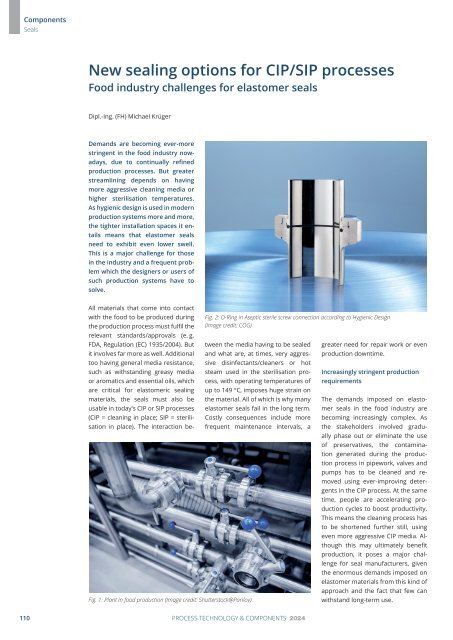PuK - Process Technology & Components 2024
A technical trade magazine with a history of more than 60 years.
A technical trade magazine with a history of more than 60 years.
Create successful ePaper yourself
Turn your PDF publications into a flip-book with our unique Google optimized e-Paper software.
<strong>Components</strong><br />
Seals<br />
New sealing options for CIP/SIP processes<br />
Food industry challenges for elastomer seals<br />
Dipl.-Ing. (FH) Michael Krüger<br />
Demands are becoming ever-more<br />
stringent in the food industry nowadays,<br />
due to continually refined<br />
production processes. But greater<br />
streamlining depends on having<br />
more aggressive cleaning media or<br />
higher sterilisation temperatures.<br />
As hygienic design is used in modern<br />
production systems more and more,<br />
the tighter installation spaces it entails<br />
means that elastomer seals<br />
need to exhibit even lower swell.<br />
This is a major challenge for those<br />
in the industry and a frequent problem<br />
which the designers or users of<br />
such production systems have to<br />
solve.<br />
All materials that come into contact<br />
with the food to be produced during<br />
the production process must fulfil the<br />
relevant standards/approvals (e. g.<br />
FDA, Regulation (EC) 1935/2004). But<br />
it involves far more as well. Additional<br />
too having general media resistance,<br />
such as withstanding greasy media<br />
or aromatics and essential oils, which<br />
are critical for elastomeric sealing<br />
materials, the seals must also be<br />
usable in today's CIP or SIP processes<br />
Fig. 1: Plant in food production (Image credit: Shutterstock@Parilov)<br />
Fig. 2: O-Ring in Aseptic sterile screw connection according to Hygienic Design<br />
(Image credit: COG)<br />
(CIP = cleaning in place; SIP = sterilisation<br />
in place). The interaction between<br />
the media having to be sealed<br />
and what are, at times, very aggressive<br />
disinfectants/cleaners or hot<br />
steam used in the sterilisation process,<br />
with operating temperatures of<br />
up to 149 °C, imposes huge strain on<br />
the material. All of which is why many<br />
elastomer seals fail in the long term.<br />
Costly consequences include more<br />
frequent maintenance intervals, a<br />
greater need for repair work or even<br />
production downtime.<br />
Increasingly stringent production<br />
requirements<br />
The demands imposed on elastomer<br />
seals in the food industry are<br />
becoming increasingly complex. As<br />
the stakeholders involved gradually<br />
phase out or eliminate the use<br />
of preservatives, the contamination<br />
genera ted during the production<br />
process in pipework, valves and<br />
pumps has to be cleaned and removed<br />
using ever-improving detergents<br />
in the CIP process. At the same<br />
time, people are accelerating production<br />
cycles to boost productivity.<br />
This means the cleaning process has<br />
to be shortened further still, using<br />
even more aggressive CIP media. Although<br />
this may ultimately benefit<br />
production, it poses a major challenge<br />
for seal manufacturers, given<br />
the enormous demands imposed on<br />
elastomer materials from this kind of<br />
approach and the fact that few can<br />
withstand long-term use.<br />
110 PROCESS TECHNOLOGY & COMPONENTS <strong>2024</strong>

















